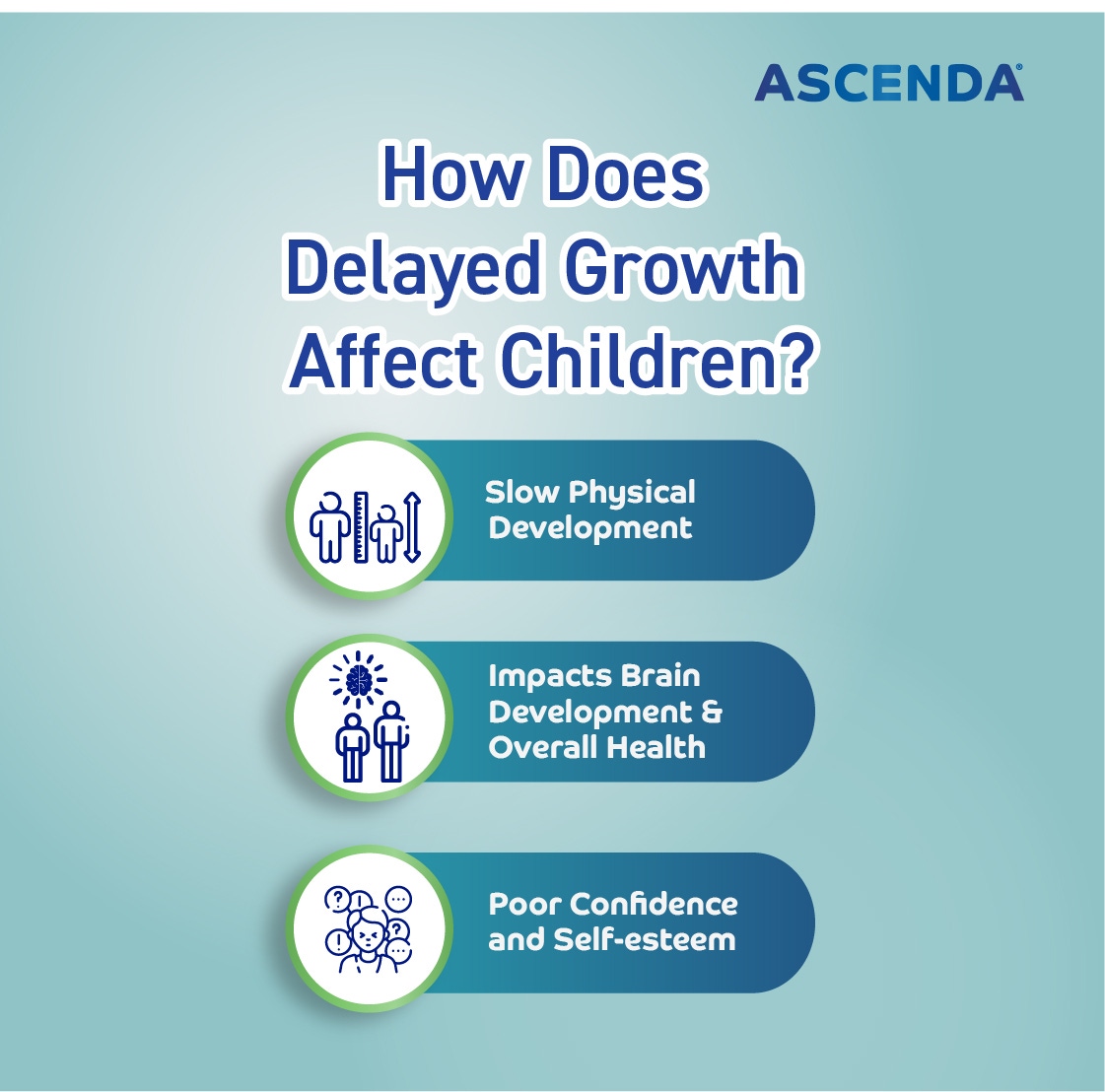
Impact of delayed growth and tips for parents to help their children
Is your child growing normally? Or do you think that your child is smaller than his friends?
It is important for parents to note that children grow and develop at a different rate and individual differences are expected. Nevertheless, your child’s growth rate can tell us about their overall health. There are various factors that can influence growth such as genetics, nutrition, hormones, etc. Delayed growth occurs when a child falls below the expected growth rate for their age. If you have a concern that your child might have a delayed growth, there is a way to tell.
What is a child’s normal growth?
A child’s normal growth can be indicated using these milestones for every stage (in terms of height measurements). Here's a breakdown to help you understand what to expect.
Toddler (1-3 years old): Toddlers grow at a rate of 10 cm a year.
Pre-school (2-5 years old): Children grow at a rate of 7-8 cm a year.
Childhood (5 years - prepubertal): Children grow at a rate of 5-6 cm a year.
Adolescence: With the onset of puberty, the effects of sex steroids and growth hormone accelerate the growth rate to 8–12 cm a year in girls and 10–14 cm a year in boys.
Impact of delayed growth in children

A delayed growth in children can sometimes contribute to lower self-esteem and social challenges due to feeling different. Their confidence and their perception about themselves could be affected. It's important to remember that every child is unique, and support plays a crucial role in helping them navigate these situations.
That is why the World Health Organisation (WHO) recognises the importance of healthy growth in early childhood highlighting its close link to overall development across cognitive, language, and motor skills.
Did you know? The first eight years of life form the critical foundation for a child's future learning, behavior, and health. In fact, a staggering 90% of a child's brain development occurs by age 5! By nurturing healthy growth during this crucial period, we can equip our little ones with the skills and resources needed to blossom into well-rounded adults.
How parents can help nurture healthy growth in children
1. Provide a balanced nutritional meal
Beyond genetics, nutrition plays a pivotal role in a child's growth and development. One of the potential long-term health consequences of childhood undernutrition is stunted growth. To ensure optimal growth and bone health, prioritise a balanced diet rich in fruits, vegetables, protein, and calcium. Encourage protein-rich choices like eggs, beans, pulses, fish, and dairy products. For calcium, consider incorporating leafy green vegetables, dairy products, and fortified cereals.

2. Ensure that a child gets enough rest and sleep
Deep sleep is essential for the secretion of the growth hormone, crucial for development. Ensure your child gets enough sleep based on their age:
1-2 years: 11-14 hours of good quality sleep (including naps)
3-5 years: 10-13 hours of good quality sleep (including naps)
6-12 years: 9-12 hours


3. Encouraging physical activity
Regular physical activity not only boosts growth hormone release but also strengthens bones and muscles. Encourage enjoyable activities like swimming, yoga, stretching, and team sports to promote healthy development. This is the duration of physical activity recommended for children.
Children 1–2 years of age should:
Spend at least 180 minutes in a variety of types of physical activities at any intensity, including moderate to vigorous-intensity physical activity, spread throughout the day.
Children 3–4 years of age should:
Spend at least 180 minutes in a variety of types of physical activities at any intensity, of which at least 60 minutes is moderate- to vigorous intensity physical activity, spread throughout the day.

How ASCENDA® Might Support Growth:
ASCENDA®, an energy and nutrient dense formula milk that is designed to address potential nutritional gaps that might contribute to slower growth. Compared to regular milk powder, ASCENDA® offers more calories per serving. This can be helpful for children with higher energy needs due to a fast metabolism or increased activity levels. These additional calories can contribute to supporting catch-up growth.
ASCENDA® is also formulated with a higher protein content than standard formulas. Protein is crucial for building and repairing muscles, bones, and tissues throughout childhood. An adequate protein intake can support healthy growth and development.
It is also scientifically formulated with 38 key nutrients and higher levels of micronutrients compared to regular milk powder. Micronutrients, such as Zinc, and Iron are key growth nutrients that help support catch-up growth by providing the building blocks needed for optimal development.
A complete diet is key for catch-up growth! Add ASCENDA® to your routine to help your child catch up on growth and learning.
References:
- 1Haymond M, Kappelgaard AM, Czernichow P, et al. Early recognition of growth abnormalities permitting early intervention. Acta Paediatrica. 2013;102(8):787-96.
- 2Sullivan PB, Goulet O. Growth faltering: how to catch up? Eur J Clin Nutr. 2010;64 (suppl 1):S1.
- 3De Onis M, Branca F. Childhood stunting: a global perspective. Matern Child Nutr. 2016; 12:12-26.
- 4Kar BR, Rao SL, Chandramouli BA. Cognitive development in children with chronic protein energy malnutrition. Behav Brain Funct. 2008;4(1):31.
- 5Loveridge N, Noble BS. Control of longitudinal growth: the role of nutrition. Eur J Clin Nutr. 1994;48:75-84.
- 6Prendergast AJ, Humphrey JH. The stunting syndrome in developing countries. J Paediatr Child Health. 2014;34(4):250-65.
- 7Huynh DT, Estorninos E, Capeding RZ, Oliver JS, Low YL, Rosales FJ. Longitudinal growth and health outcomes in nutritionally at-risk children who received long-term nutritional intervention. J Hum Nutr Diet. 2015;28(6):623-35.
- 8Ghosh AK, Kishore B, Shaikh I, et al. Continuation of oral nutritional supplementation supports continued growth in nutritionally at-risk children with picky eating behaviour: A post-intervention, observational follow-up study. J Int Med Res. 2018;46(7):2615-32.
- 9Huynh DT, Estorninos E, Capeding MR, et al. Impact of long-term use of oral nutritional supplement on nutritional adequacy, dietary diversity, food intake and growth of Filipino preschool children. J Nutr Sci. 2016;5(e20):1-11.
- 10Sheng X, Tong M, Zhao D, et al. Randomized controlled trial to compare growth parameters and nutrient adequacy in children with picky eating behaviors who received nutritional counseling with or without an oral nutritional supplement. Nutr Metab Insights. 2014;7:NMI-S15097.
- 11Alarcon PA, Lin LH, Noche Jr M, et al. Effect of oral supplementation on catch-up growth in picky eaters. Clin Pediatr. 2003;42(3):209-17.


















